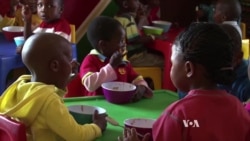Every day, one in four South Africans faces hunger. The number of children with severe stunting due to malnutrition has increased in the past few years. Yet the international group Oxfam says the problem is absent from public debate in a country that is self-sufficient in food production. A lack of education and limited access to affordable, balanced foods are some of the main causes of hunger.
These children eating their morning porridge are not in a school canteen, but in a rehabilitation center for malnourished children. In South Africa, official statistics show almost a quarter of the population faces hunger on a regular basis.
The country is considered food-secure, but factors such as price inflation and high unemployment prevent some from accessing not only enough food, but also enough quality food.
According to Oxfam's Rashmi Mistry, a chronic lack of nutrition affects 25 percent of children with serious consequences.
“Stunting and malnutrition start in the womb. When mothers don't have enough to eat, or don't have the right type of food to eat, then it impacts on the feed system and it starts from there. If you've got a few rands to spend on food, you're gonna buy something that fills you up, and that's usually starches. Potatoes, rice, or mealie meal [corn flour]. They'll fill you up. But those foods have very little nutrition," said Mistry.
In the past six years, the cost for a basic food basket here increased by more than 40 percent.
To help people be able to afford healthy food, the NGO African Children Feeding Scheme, or ACFS, is teaching adults how to grow their own food.
Nosipho Siswene lives on a government stipend of $86 a month to feed her family of five. She says since she started a garden, she saves half of her food budget.
“I didn't like gardening before because I didn't understand anything about it. But after I got taught on how to do the garden, I quickly loved it. I'm saving money because I don't have to buy all these veggies anymore. I eat healthy food now because I get them fresh from my garden," said Siswene.
Education on what constitutes a balanced diet is another tool in combating hunger here.
”We have three kinds of food: we have the carbohydrates, we have the protein and we have the vitamins," said a nutrition instructor.
This ACFS staffer is training women on not only what to grow but what to eat.
Many in the class said they have gained a lot of valuable information.
“The nutrition classes taught me that we mustn't give children junk food or take-away or porridge at every meal. We have to do a proper balanced diet for the child so he's able to do well at school," said Angelina Sekoto.
ACFS has been operating here for more than 60 years and provides support to hundreds of families every day. Executive Director Phindile Hlalele says the need for its services has not decreased, but donations have.
“The need is huge. It's not decreasing, it's huge. We're still proceeding as we used to. But in the future, if things don't become better, we'll have to scale it down [our activities]," said Hlalele.
In its recent report, Oxfam recommends South Africa’s government introduce a national food act in order to eradicate hunger and malnutrition. While the “right to food” is enshrined in South Africa’s constitution, it appears not yet to be completely in practice.







